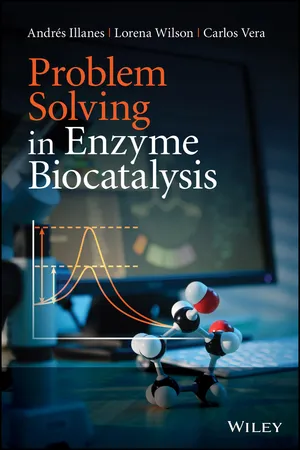
- English
- ePUB (mobile friendly)
- Available on iOS & Android
Problem Solving in Enzyme Biocatalysis
About this book
Enzyme biocatalysis is a fast-growing area in process biotechnology that has expanded from the traditional fields of foods, detergents, and leather applications to more sophisticated uses in the pharmaceutical and fine-chemicals sectors and environmental management. Conventional applications of industrial enzymes are expected to grow, with major opportunities in the detergent and animal feed sectors, and new uses in biofuel production and human and animal therapy.
In order to design more efficient enzyme reactors and evaluate performance properly, sound mathematical expressions must be developed which consider enzyme kinetics, material balances, and eventual mass transfer limitations. With a focus on problem solving, each chapter provides abridged coverage of the subject, followed by a number of solved problems illustrating resolution procedures and the main concepts underlying them, plus supplementary questions and answers.
Based on more than 50 years of teaching experience, Problem Solving in Enzyme Biocatalysis is a unique reference for students of chemical and biochemical engineering, as well as biochemists and chemists dealing with bioprocesses.
Contains: Enzyme properties and applications; enzyme kinetics; enzyme reactor design and operation 146 worked problems and solutions in enzyme biocatalysis.
Frequently asked questions
- Essential is ideal for learners and professionals who enjoy exploring a wide range of subjects. Access the Essential Library with 800,000+ trusted titles and best-sellers across business, personal growth, and the humanities. Includes unlimited reading time and Standard Read Aloud voice.
- Complete: Perfect for advanced learners and researchers needing full, unrestricted access. Unlock 1.4M+ books across hundreds of subjects, including academic and specialized titles. The Complete Plan also includes advanced features like Premium Read Aloud and Research Assistant.
Please note we cannot support devices running on iOS 13 and Android 7 or earlier. Learn more about using the app.
Information
1.1 Introduction
1.1.1 Enzyme Properties
1.1.2 Enzyme Applications
- Chemical and clinical analysis, due to their high specificity and sensibility, which allow the quantification of various analytes with high precision. Worth mentioning are their uses in flow injection analysis [10], robust electrodes for process control [11], and nanosensors [12]. Enzymes are also widely used in various diagnostic kits and as detectors in immunoassays [13].
- Therapy, due to their high specificity and activity, which allow the precise and efficient removal of unwanted metabolites. Many therapeutic applications have been envisaged, including for such enzymes as asparaginase, billirubin oxidase, carboxypeptidase, α-glucosidase, α-galactosidase, phenylalanine ammonia lyase, streptokinase, urease, uricase, and urokinase. The US Food and Drug Administration (FDA) has already approved applications in cardiovascular disorders, pancreatic insufficiency, several types of cancer, the replacement therapy for genetic deficiencies, the debridement of wounds, and the removal of various toxic metabolites from the bloodstream [14].
- Environmental management (waste treatment and bioremediation). Enzyme specificity allows the removal of particularly recalcitrant pollutants from hard industrial wastes and highly diluted effluents. Enzymes are also used in the final polishing of municipal and industrial effluents following conventional treatment and as enhancers of the hydrolytic potential of the microbial consortia in the first step of anaerobic digestion [15]. In addition, they are increasingly being used in bioremediation of polluted soils and waters with recalcitrant compounds [16], although the high cost of the enzymes is still prohibitive in most such cases [17].
- Biotechnological research and development. Enzymes are fundamental components of the toolbox for biotechnology research, especially in the areas of molecular biology and genetic engineering. Thermostable DNA polymerases are the basis of the polymerase chain reaction (PCR) [18], which is fundamental to gene amplification, while restriction endonucleases and ligases are fundamental tools in recombinant DNA technology [19].
1.2 Enzymes as Process Catalysts
| Enzyme | Source | Application |
| Carbohydrases | ||
| α-amylase | mold | bakery, confectionery, brewery, bioethanol |
| α-amylase | bacterium | starch liquefaction, detergent, textil... |
Table of contents
- Cover
- Title Page
- Copyright
- Preface
- Nomenclature
- Epsilon Software Information
- Acknowledgement
- Chapter 1: Facts and Figures in Enzyme Biocatalysis
- Chapter 2: Enzyme Kinetics in a Homogeneous System
- Chapter 3: Enzyme Kinetics in a Heterogeneous System
- Chapter 4: Enzyme Reactor Design and Operation under Ideal Conditions
- Chapter 5: Enzyme Reactor Design and Operation under Mass-Transfer Limitations
- Chapter 6: Enzyme Reactor Design and Operation under Biocatalyst Inactivation
- Chapter 7: Optimization of Enzyme Reactor Operation
- Appendix A: Mathematical Methods
- Index